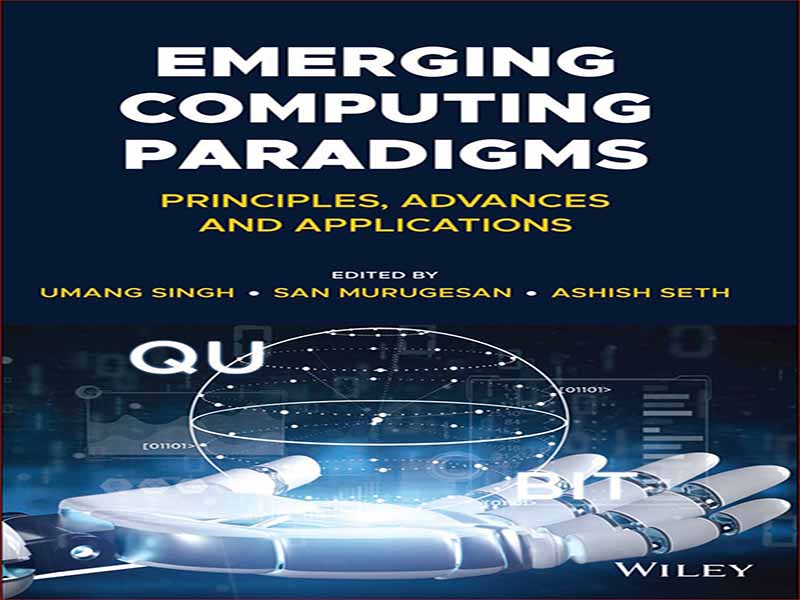- عنوان کتاب: Emerging Computing Paradigms / Principles, Advances and Applications
- نویسنده: San Murugesan, Ashish Seth
- حوزه: آینده پژوهی
- سال انتشار: 2022
- تعداد صفحه: 305
- زبان اصلی: انگلیسی
- نوع فایل: pdf
- حجم فایل: 8.19 مگابایت
سال 2021 هفتاد و پنجمین سالگرد اولین کامپیوتر دیجیتال الکترونیکی عمومی، پنجاهمین سالگرد ریزپردازنده و چهلمین سالگرد رایانه شخصی IBM است. این تحولات تاریخی پایه و اساس پیشرفت های شگفت انگیز مداوم در محاسبات و فناوری اطلاعات را تشکیل داد. در یک بازه زمانی 75 ساله، از فناوری اثبات نشده تا فناوری که عمیقاً در تمام جنبه های کار و زندگی روزمره ما تعبیه شده است، رایانه ها پیشرفت چشمگیری داشته اند. تاریخچه کامپیوترهای مدرن به ENIAC (انتگرالکننده عددی الکترونیکی و کامپیوتر)، اولین کامپیوتر الکترونیکی قابل برنامهریزی عمومی (لوله خلاء) برمیگردد که در 14 فوریه 1946 در معرض دید عموم قرار گرفت. جان ماچلی و جی. پرسپر اکرت در دانشگاه پنسیلوانیا آن را مخفیانه برای ارتش ایالات متحده توسعه داد تا جداول مسیر بالستیک را به طور موثرتری نسبت به تحلیلگرهای دیفرانسیل مکانیکی مورد استفاده در آن زمان محاسبه کند. علاوه بر استفاده از آن برای تحقیقات مسیر بالستیک، ENIAC همچنین برای شبیه سازی مونت کارلو، پیش بینی آب و هوا و تحقیقات اولیه بمب هیدروژنی استفاده شد. در آستانه رونمایی از ENIAC، وزارت جنگ ایالات متحده با انتشار بیانیهای از آن به عنوان «ماشین جدیدی که انتظار میرود انقلابی در ریاضیات مهندسی ایجاد کند و بسیاری از روشهای طراحی صنعتی ما را تغییر دهد» ستایش کرد. بدون شک، کامپیوترهای دیجیتال الکترونیکی مهندسی و ریاضیات و همچنین هر حوزه قابل تصور دیگری را به طور غیرقابل برگشتی متحول کردند. در سال 1958، جک کیلبی از تگزاس اینسترومنتز اولین مدار مجتمع (IC) را اختراع کرد. با اتخاذ یکپارچگی در مقیاس بزرگ، ادغام در مقیاس بسیار بزرگ و ادغام در مقیاس فوقالعاده، چگالی آیسیها با پیروی از قانون مور همچنان افزایش مییابد – تعداد ترانزیستورها در یک تراشه تقریباً هر 24 ماه دو برابر میشود. در سال 1971، شرکت اینتل، اولین ریزپردازنده جهان را منتشر کرد، یک واحد پردازشگر مرکزی همه منظوره کامل یک کامپیوتر روی یک آی سی واحد. تحولات شگفت انگیزی در سخت افزار، نرم افزار و شبکه و ارتباطات به دنبال داشت و جهان را به طور غیرقابل برگشتی تغییر داد. از آنجایی که رایانهها در 75 سال گذشته تقریباً هر بخش از زندگی ما را بازتعریف و تغییر دادهاند، هنوز بر اساس همان مفاهیم اساسی محاسباتی که در ابتدا پیشبینی شده بود، عمل میکنند. با افزایش تقاضا برای محاسبات، ذخیره سازی و ارتباطات، رایانه های دیجیتال مبتنی بر سیلیکون و معماری معمولی به محدودیت های خود نزدیک می شوند و با مسائل مربوط به اقتصاد و قابلیت اطمینان مواجه می شوند. بنابراین، انواع خاصی از مشکلات در حوزههایی مانند پیشبینی آب و هوا، بیوانفورماتیک، روباتیک و سیستمهای مستقل با محدودیتهای مرتبط با پارادایم محاسباتی مرسوم مواجه هستند.
2021 marks the 75th anniversary of the first general purpose electronic digital computer, the 50th anniversary of the microprocessor, and the 40th anniversary of the IBM Personal Computer. These historic developments formed the foundation for amazing continuing advances in computing and IT. In a span of 75 years, from an unproven technology to one that is embedded deeply into every aspect of our work and our daily lives, computers have advanced significantly. The history of the modern computer has its origin to ENIAC (Electronic Numerical Integrator and Computer), the first general purpose programmable electronic (vacuum- tube) computer, unveiled to public on February 14, 1946. John Mauchly and J. Presper Eckert at the University of Pennsylvania developed it secretly for the US Army to calculate ballistic trajectory tables more effectively than the mechanical differential analyzers in use at the time. Besides using it for ballistics trajectory research, ENIAC was also used for Monte Carlo simulations, weather predictions, and early hydrogen bomb research. On the eve of unveiling of ENIAC, the US War Department put out a press release hailing it as “a new machine that is expected to revolutionize the mathematics of engineering and change many of our industrial design methods.” Without doubt, electronic digital computers did transform irrevocably engineering and mathematics, and also every other conceivable domain. In 1958, Jack Kilby of Texas Instruments invented the first integrated circuit (IC). Adopting large-scale-integration, very large-scale-integration, and ultra-large-scale integration, the density of ICs continued to increase, closely following the Moore’s Law—the number of transistors in a chip will approximately double every 24 months. In 1971, Intel Corporation, released the world’s first microprocessor, a complete general-purpose central processor unit of a computer on a single IC. Amazing developments in hardware, software, and networking and communication followed, and changed the world irrevocably. As computers have evolved to redefine and transform almost every area of our lives in the past 75 years, they still function on the same fundamental computational concepts envisaged at the beginning. As demands on computing, storage, and communication continue to escalate, digital computers based on silicon and conventional architecture approach their limits and face issues related to economics and reliability. Thus, certain kinds of problems in domains such as weather forecasting, bioinformatics, robotics, and autonomous systems are faced with limitations tied to the conventional computing paradigm.
این کتاب را میتوانید بصورت رایگان از لینک زیر دانلود نمایید.
Download: Emerging Computing Paradigms



































نظرات کاربران